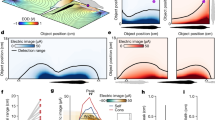Abstract
The remarkable capacity of an observer to perceive and recognize objects and forms independent of the exact nature of their components can be described as a process of reconstruction. We have measured the ability of human observers to recognize square-wave or sinusoidal gratings when presented as a pattern of regularly taken spatial samples (see Fig. 1). To recognize the waveforms, the observer must visually reconstruct them from the samples—a process which can be described by the Shannon–Whittaker theorem1,2 of sampling and which Barlow suggests may be carried out by the numerous stellate cells of the visual cortex3. We report here that at low spatial frequencies, relatively more sample lines per spatial cycle were needed for wave recognition than were needed at higher frequencies. However, a square-wave grating was still recognized easily even when it was sampled at a rate at which its third harmonic could not be recognized when presented alone. At high spatial frequencies the square wave was identified when the sampling rate was so low that it caused the third harmonic to be under-sampled. This contradicts the idea that a complex wave is analysed by parallel spatial frequency channels4,5 and emphasizes the capacity of the visual system to use signal features other than the harmonic frequency components of an image to recognize it.
This is a preview of subscription content, access via your institution
Access options
Subscribe to this journal
Receive 51 print issues and online access
$199.00 per year
only $3.90 per issue
Buy this article
- Purchase on Springer Link
- Instant access to full article PDF
Prices may be subject to local taxes which are calculated during checkout
Similar content being viewed by others
References
Shannon, C. E. Proc. IRE 37, 10 (1949).
Whittaker, E. T. Proc. R. Soc. Edinb. A35, 181 (1915).
Barlow, H. B. Nature 279, 189 (1979).
Campbell, F. W. & Robson, J. G. J. Physiol., Lond. 197, 551 (1968).
Maffei, L. & Fiorentini, A. Nature 240, 479 (1972).
Logan, B. F. Bell Syst. tech. J. 56, 487 (1977).
Bracewell, R. The Fourier Transform and Its Applications (McGraw–Hill, New York, 1978).
Marr, D. Phil. Trans. R. Soc. B275, 483 (1976).
Marr, D. & Hildreth, E. Proc. R. Soc. B207, 187 (1980).
Author information
Authors and Affiliations
Rights and permissions
About this article
Cite this article
Nyman, G., Laurinen, P. Reconstruction of spatial information in the human visual system. Nature 297, 324–325 (1982). https://doi.org/10.1038/297324a0
Received:
Accepted:
Issue Date:
DOI: https://doi.org/10.1038/297324a0
This article is cited by
-
Mechanisms of interpolation in human spatial vision
Nature (1982)
Comments
By submitting a comment you agree to abide by our Terms and Community Guidelines. If you find something abusive or that does not comply with our terms or guidelines please flag it as inappropriate.



